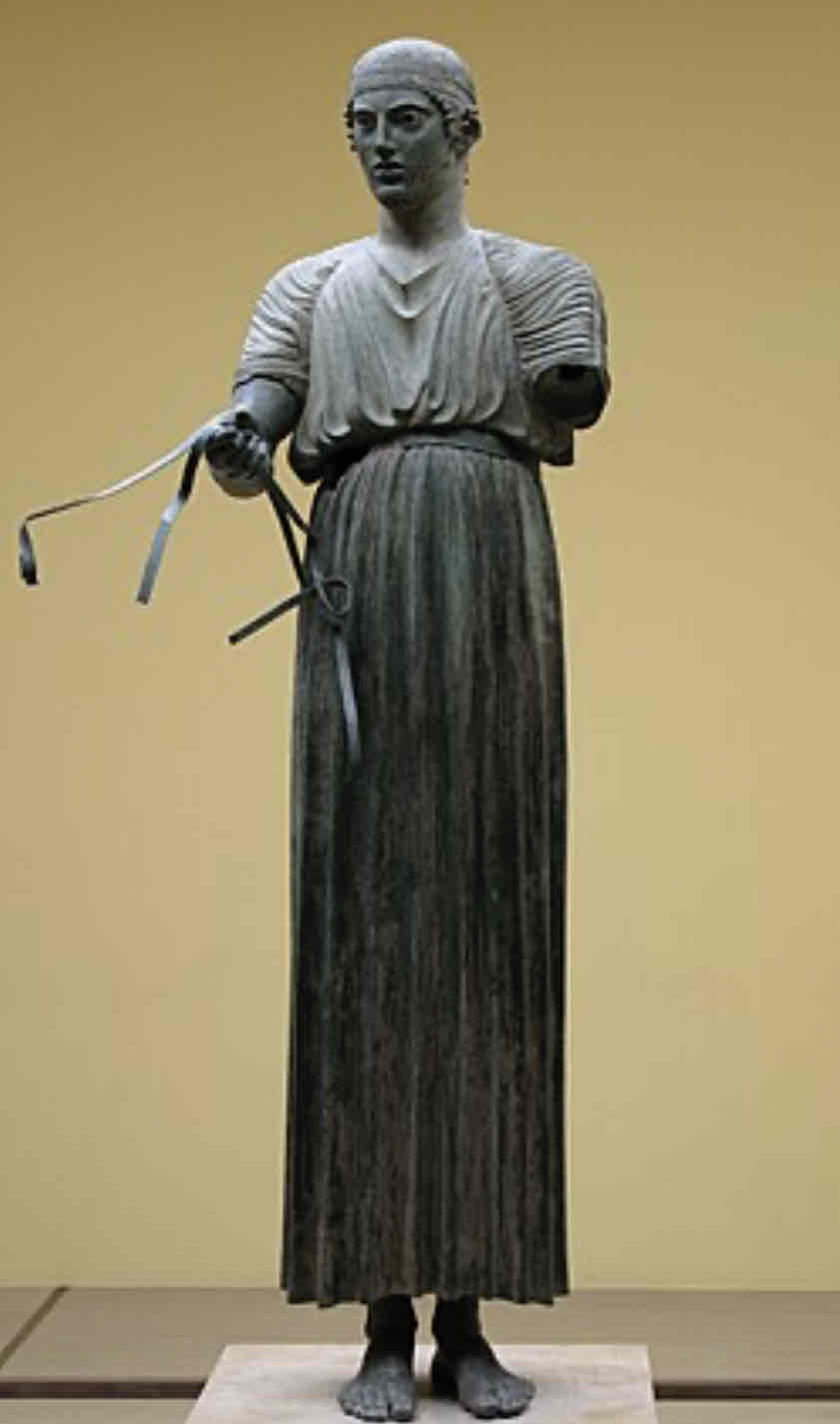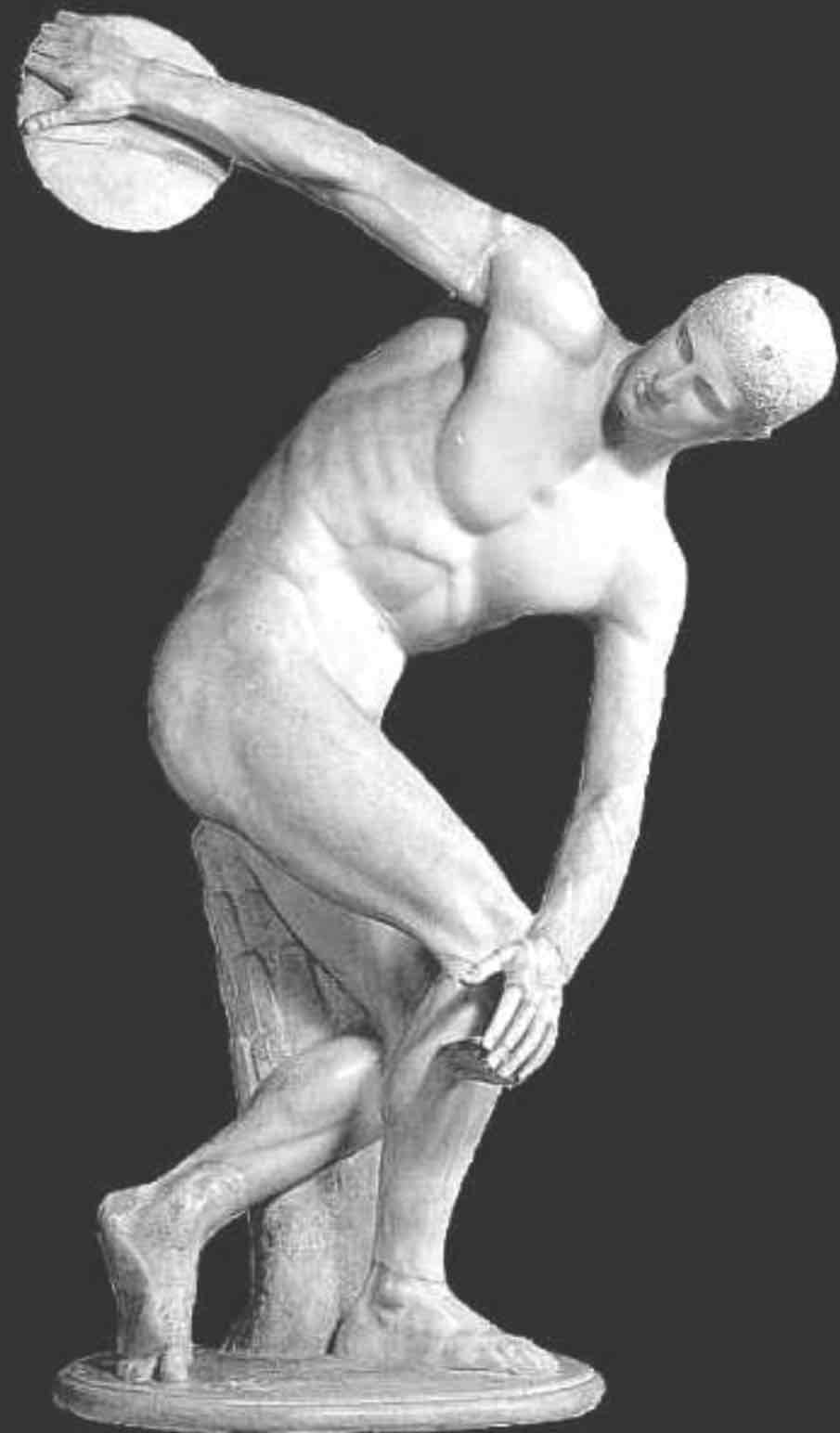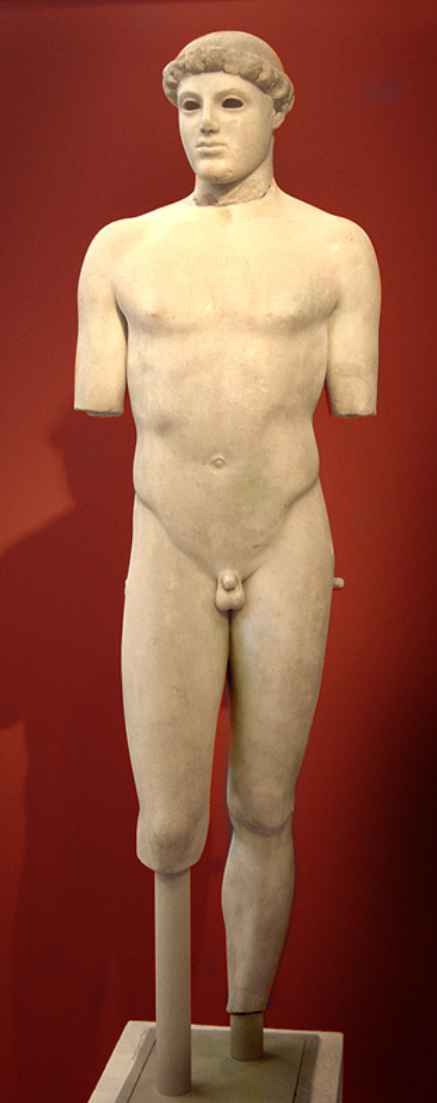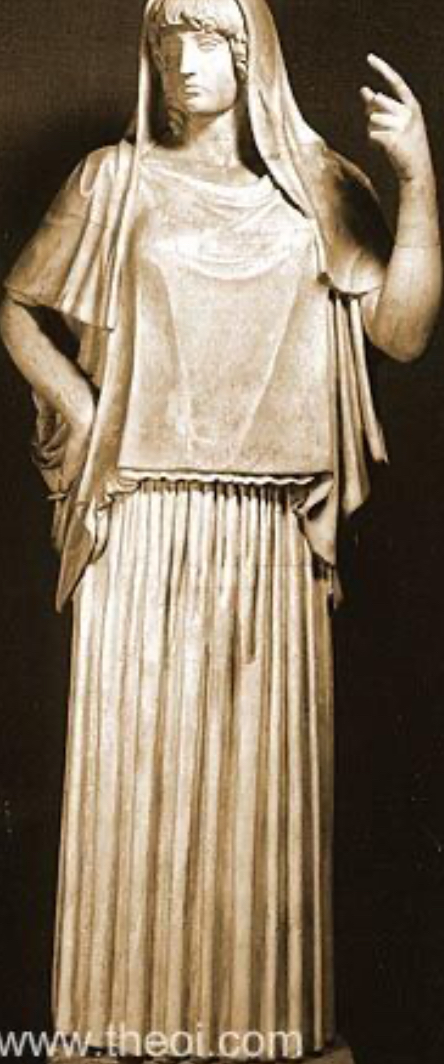Early Classical period prescribed statues
1/24
There's no tags or description
Looks like no tags are added yet.
Name | Mastery | Learn | Test | Matching | Spaced |
|---|
No study sessions yet.
25 Terms

The Delphic Charioteer
Height? Date? Material? Location?
Height: 1.80m
Date: Either 478 or 474 BC
Material: Multi-media hollow bronze statue→copper (lips, eyelashes), silver (teeth, fillet) and onyx for the eyes
Location: Part of a votive offering at the Panhellenic sanctuary of Apollo at Delphi, now located in the museum of Delphi
The Delphic Charioteer
Contextual Knowledge → Why was it erected?
It is a votive statue offered at the Panhellenic sanctuary of Apollo at Delphi. It was dedicated after a victory at the Pythian games by a tyrant called Polyzalos of Gela. The inscription on the base of the statue reads
‘Polyzalos dedicated me. … Make him prosper, honoured Apollo’
How was Chariot racing significant in Ancient Greece?
By the archaic and classical periods, chariot races were a prominent part of Olympic games and Pythian games at Delphi with purpose built hippodromes. It gained you kleos and time (honour) and was a display of arete.
The Delphic Charioteer
What makes the Delphic Charioteer aesthetically pleasing? (give 5 points with examples)
The sculptors use of multi-media seen in the use of copper for the eyelashes and lips and the use of silver in the fillet and onyx and black agate in the in-laid eyes and of course bronze for the rest of the statue. This shows the sculptors techne through their ability to work with multiple mediums and also their wealth
It is a display of piety as a votive statue to Apollo e.g. the inscription
It displays a clear narrative through the group composition and the reins and the fillet (a symbol of victory)
The concentrated and almost severe style facial expression gives a sense of realism and narrative e.g. pursued full lips, heavy chin, oval face, alert and attentive eyes and also the rigid posture
fluting and curvilinear features seen in the upper drapery and deep folds created by the cross brace on the back
The Delphic Charioteer
What makes him less aesthetically pleasing?
The fluting of the lower drapery gives no sense of anatomy beneath the xystis and makes the legs appear extremely elongated giving it a lack of realism. However in the whole group composition this part of the body would have been hidden.
The contrast between the light and crinkled folds of the upper torso’s drapery and the heavy drapery below the waist gives a sense on inconsistency and makes them seem like they are made from different materials
The rigid asymmetric action pose seems restrained and primitive like the archaic statues. There is a slight twist and the waist and turn of the head to the right but it offers barely any movement or realism
The lack of emotion in the facial expression ‘severe style’
The Delphic Charioteer
How is the Delphic Charioteer more advanced than earlier archaic statues?
He is clothed and has more complex drapery
There is no archaic smile
He is made from bronze and also has multi-media
He is part of a group composition and has props
Age is conveyed more through the youthful curls and full face
Less focus on displaying an ideal and more on the narrative
Realism
Movement in pose
More free standing- no plinth or hair support
The Delphic Charioteer
What parts of the statue show remnants of archaic features?
The planted feet
The Geometric patterns used in the silver fillet
The Delphic Charioteer
Scholar Quotes
Richard Neer: ‘He had been flagrantly inconsistent in rendering the chiton (xystis)’
Barringer: ‘He appears alert and attentive’

The Artemision Zeus
Height? Date? Material? Location?
Height: 2.09m
Date: c.460-450 BC
Material: Hollow Bronze statue with copper lips and nipples and ivory/bone inlaid eyes and on the eyebrows
Location: It was found in the sea off Cape Artemisium and is now located in the national archaeological museum in Athens, Greece
The Artemision Zeus
What is debate about his missing prop?
In the flexed bent throwing arm his hand is held in a wide grasp. People debate whether he was Zeus holding a thunderbolt or Poseidon wielding his trident.
The Artemision Zeus
What makes him aesthetically pleasing? (5 points)
The cold work seen in his beard and parted fringe are particularly detailed and intricate. This is a great display of the sculptors techne and gives the sculpture and more naturalistic and impressive look.
The dynamic and daring pose portrays a narrative of a figure caught in movement. It shows the unfolding of time and displays the narrative of a man or god about to throw something. e.g. the out-stretched aiming arm and the flexed throwing arm
The triangles formed by the pose create a symmetrically pleasing look
Nudity and the size of 2.09m makes him feel impressive and shows his strength and arete
Use of multimedia
The Artemision Zeus
What makes him less aesthetically pleasing?
He is not made for in the round viewing as he looks incredible from the front and back but is less powerful and effective from the side views
The torso does not react to the out-stretched action limbs → not realistic
Severe emotionless facial expression
The Artemision Zeus
What features of the early classical period does he show? How has he advanced from the archaic period?
Use of bronze and multi-media
Severe style facial expression e.g. pursued lips, determined inlaid eyes locked on target, furrowed brows
Facial hair and the use of cold work show age differentiation
Dynamic action pose
Missing prop
No archaic smile
The Artemision Zeus
Scholar Quotes
Boardman: ‘vigorously threatening and static in its perfect balance’
Neer: ‘The Artemision sculptor has elongated the left arm to nearly simian length’

Myron’s Diskobolos
Height? Date? Material? Location?
Height: 1.55M
Date: Greek original, 460-450 BC
Material: Roman marble copy of the original bronze
Location: British Museum
Myron’s Diskobolos
What makes him aesthetically pleasing?
Didactic pose: message of arete →ideal male athletic physique seen in the large pectorals and musculature→ gives the Greek audience something to strive for
Contrasting shapes: soft arcs of extended arms vs sharp zig zags of back and back flexed legs→ show this strain but also the beauty of his movemnt
Rich relatable narrative conveying the tension of the athlete before he releases the discus →the use of the discus as a prop held in an outstretched flexed throwing arm→ the figures whole body is harmonious and reacting to this movement with his head turned, knees bent and his left toes dragging
Message of Kinesis→right planted foot, dragging left toes and raised left foot, arc of back and hip
Myron’s Diskobolos
What makes him less aesthetically pleasing?
Designed only for frontal view but is in the round→the side view is not visually effective
The torso does not fully react to the action limbs and there is no real strain within the body which is highly unrealistic
Myron’s Diskobolos
Scholar Quotes
Boardman: ‘The figure is cut in one plane for a single view point’
Woodford: ‘new aesthetic’ ‘curved versus straight’ ‘smooth versus angular’

UNPRESCRIBED STATUE
The Kritios Boy
Height? Date? Material? Location?
Height: 1.17M (under life size)
Date: c.490-480 BC
Material: Parian marble
Location: From the Acropolis, Athens
UNPRESCRIBED STATUE
How did the Kritios boy show advancements from the Archaic period?
The influence of Bronze on Marble: inlaid eyes, grooved hair with chased detail
Change in the pose: Asymmetric pose with the weight shifted on the back leg, flexed right knee, raised left hip and relaxed right buttock
The Anatomy and the Characterisation of Age: His anatomy is slightly undeveloped with his face having a soft rounded look unlike the musculature of later archaic statues e.g. Kleobis and Biton

UNPRESCRIBED STATUE
The Giustiniani Hestia
Height? Date? Material?
Height: 1.93M
Date: 470 BC
Material: Roman marble copy of an original bronze
UNPRESCRIBED STATUE
Name 4 aesthetic features of the Giustiniani Hestia
Pose: Left arm raised with her right arm placed on her hip, her head is slightly turned to the right
Drapery: Large heavy peoples with no sense of movement beneath it, the horizontal hem vs deep vertical fluting, subtle catenary on upper drapery highlights breasts, veil creates a contrast between light and dark
Facial expression: Severe style face with pursued lips and devoid eyes
Hair: Curled hair locks, thick fringe

UNPRESCRIBED
The Riace Bronzes
Height? Date? Material? Location?
Height: Warrior A= 2.05M, Warrior B= 1.96M
Date: 460-450 BC
Material: Bronze
Location: Found in the ocean of the Southern Italian town of Riace
UNPRESCRIBED
What makes the Riace Bronzes aesthetically pleasing?
Cold work in the beard and hair to create finely curled ringlets
Dynamic pose, nearly full contrapposto, with the flexible ‘s’ down the spine and the front of the body
Use of multimedia in bronze and inlaid eyes
UNPRESCRIBED
What makes the Riace Bronzes less aesthetically pleasing?
The musculature, e.g. the iliac crest and pectorals, are beyond naturalism and highly exaggerated
The legs have been elongated